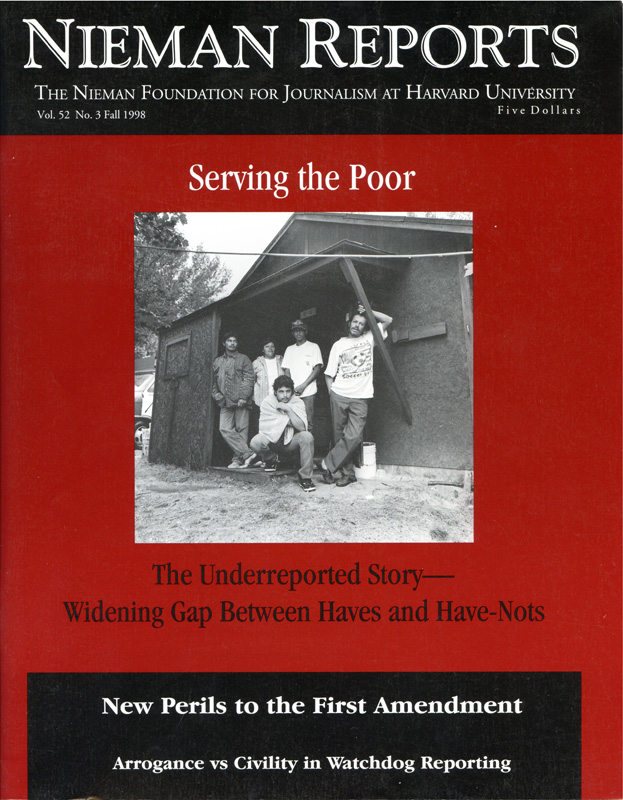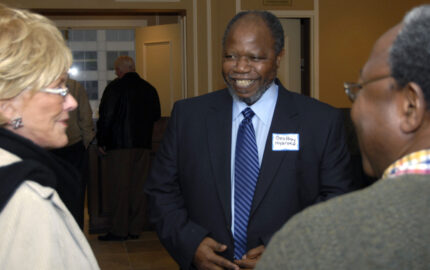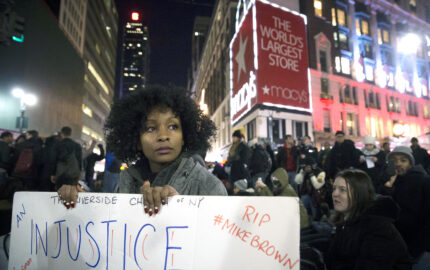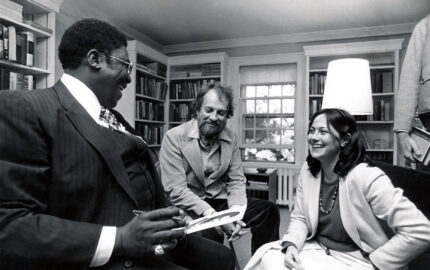The Philippine press is considered by many the liveliest, the most confrontational and even the wildest in Asia. Get out of it for a year, as I did in 1987 for my Nieman year, and you realize that 365 issues of a Philippine newspaper a year can be a blur that gives little sense of what’s really happening. A big story breaks one week; the next week it’s forgotten. For a country whose governments one international rating agency put in its top 10 list of the most corrupt bureaucracies in the world, there has been little tradition of rigorous muckraking. But things have been changing. Muckraking has taken hold.
I convinced the Asia Foundation, which funded my Nieman Fellowship, to extend my stay at Harvard to do a two-month research project on this lack of investigative reporting and on how American media’s experience could be of help—what with the Pentagon Papers and Watergate demonstrating quite dramatically how the press could change things. Howard Simons, Nieman Curator at that time, was excited over the idea and encouraged me.
I read nearly every book on the topic—there were not too many of them at Widener Library—interviewed directors of investigative journalism and wrote a research study explaining how a center could be set up in the Philippines. About a year after I got back, a group of us sharing the same concerns decided to do something about it. We rewrote my research paper into a project proposal and got the Asia Foundation to fund what we called the Philippine Center For Investigative Journalism.
That was nine years ago. After its first years, when it seemed to be ready to fold up for lack of funding and newspaper publishers’ unwillingness to support it, the PCIJ has become a respected journalism institution in the country. It does far more than trade tips on reporting techniques. It publishes reports that have won media awards in the country year after year. Dial its trunk line now, and you’ll be asked what section of it you want to reach: women’s desk, environment, publishing, training and editorial. It even has its own quarterly magazine, “I” (as in investigative), a combination perhaps of the 1970’s Ramparts or Rolling Stone (when that magazine was still a serious one), and Nieman Reports.
It has broken stories that have made an impact on government, such as corruption in the Supreme Court and its most recent one, exposing one top politician’s involvement in a major scam. After the success of its first book, which looked in-depth on the coup attempts during former president Corazon Aquino’s administration, the PCIJ has published nearly two dozen books on such diverse issues as corruption in government, the Japanese troops’ sex-slaves during the war, to one on “computer-assisted research and reporting in the Philippines.” It has even gone into broadcast media with its video reports. Journalism schools in the country have been queuing up to get their students accepted as interns into the center.
It has evolved. At the start, it was modestly seen to be just a center administering a fund raised from development agencies: it would fund reporters who’d want to take off from their daily grind and do in-depth pieces, with the PCIJ’s board giving advice and editorial help. It still does that, but now it mostly relies on its own stable of investigative reporters, whose articles are published in the major dailies.
The PCIJ has helped change Philippine journalism. Two years after it started coming out with its investigative reports, the major dailies organized their own investigative teams and several newspapers now regularly have their own special, in-depth reports.
It’s a success story of an NGO, non-governmental organization, committed to a specific cause and funded by both foreign and local development agencies. The U.S. Congress-financed Asia Foundation, which was its main source of funding in its first few years, viewed it as a legitimate project for its worldwide program to help the development of democratization in developing countries.
For several years, however, PCIJ has not been relying on that institution. Other foreign and local development agencies—and even local philanthropic foundations—have been funding it for specific topics it is interested in. The overhead for these projects help pay for the PCIJ’s own projects. It has become a full-fledged publishing house, with the center’s books being profitable—surprisingly in the Philippines. The center also conducts training for writers and would-be journalists for a fee. It has even organized international seminars on journalism topics funded by United Nations agencies and other multilateral institutions.
As in any organization, it’s not funding that made it successful, though that has been most crucial. It was the people wanting it to succeed: a group of journalists who were committed to the idea that there was a different way of doing journalism in the country, even if work in that kind of job didn’t pay well. Among them: its executive director Sheila Coronel; incoming Nieman Fellow Malou Mangahas; Nieman ’87 Marites Vitug; the country’s ecology expert, Howie Severino, and its Editor Lorna Kalaw-Tirol.
After his year as a Nieman Fellow Bobi Tiglao returned to The Manila Chronicle as Business Editor and Assistant Managing Editor. He joined The Far Eastern Economic Review as correspondent in 1989 and has been its Manila Bureau Chief. His wife, Raquel, who also attended classes and seminars at Harvard, mostly on women’s issues, heads the Women’s Crisis Center, helping rape victims, prostituted women and battered wives.
I convinced the Asia Foundation, which funded my Nieman Fellowship, to extend my stay at Harvard to do a two-month research project on this lack of investigative reporting and on how American media’s experience could be of help—what with the Pentagon Papers and Watergate demonstrating quite dramatically how the press could change things. Howard Simons, Nieman Curator at that time, was excited over the idea and encouraged me.
I read nearly every book on the topic—there were not too many of them at Widener Library—interviewed directors of investigative journalism and wrote a research study explaining how a center could be set up in the Philippines. About a year after I got back, a group of us sharing the same concerns decided to do something about it. We rewrote my research paper into a project proposal and got the Asia Foundation to fund what we called the Philippine Center For Investigative Journalism.
That was nine years ago. After its first years, when it seemed to be ready to fold up for lack of funding and newspaper publishers’ unwillingness to support it, the PCIJ has become a respected journalism institution in the country. It does far more than trade tips on reporting techniques. It publishes reports that have won media awards in the country year after year. Dial its trunk line now, and you’ll be asked what section of it you want to reach: women’s desk, environment, publishing, training and editorial. It even has its own quarterly magazine, “I” (as in investigative), a combination perhaps of the 1970’s Ramparts or Rolling Stone (when that magazine was still a serious one), and Nieman Reports.
It has broken stories that have made an impact on government, such as corruption in the Supreme Court and its most recent one, exposing one top politician’s involvement in a major scam. After the success of its first book, which looked in-depth on the coup attempts during former president Corazon Aquino’s administration, the PCIJ has published nearly two dozen books on such diverse issues as corruption in government, the Japanese troops’ sex-slaves during the war, to one on “computer-assisted research and reporting in the Philippines.” It has even gone into broadcast media with its video reports. Journalism schools in the country have been queuing up to get their students accepted as interns into the center.
It has evolved. At the start, it was modestly seen to be just a center administering a fund raised from development agencies: it would fund reporters who’d want to take off from their daily grind and do in-depth pieces, with the PCIJ’s board giving advice and editorial help. It still does that, but now it mostly relies on its own stable of investigative reporters, whose articles are published in the major dailies.
The PCIJ has helped change Philippine journalism. Two years after it started coming out with its investigative reports, the major dailies organized their own investigative teams and several newspapers now regularly have their own special, in-depth reports.
It’s a success story of an NGO, non-governmental organization, committed to a specific cause and funded by both foreign and local development agencies. The U.S. Congress-financed Asia Foundation, which was its main source of funding in its first few years, viewed it as a legitimate project for its worldwide program to help the development of democratization in developing countries.
For several years, however, PCIJ has not been relying on that institution. Other foreign and local development agencies—and even local philanthropic foundations—have been funding it for specific topics it is interested in. The overhead for these projects help pay for the PCIJ’s own projects. It has become a full-fledged publishing house, with the center’s books being profitable—surprisingly in the Philippines. The center also conducts training for writers and would-be journalists for a fee. It has even organized international seminars on journalism topics funded by United Nations agencies and other multilateral institutions.
As in any organization, it’s not funding that made it successful, though that has been most crucial. It was the people wanting it to succeed: a group of journalists who were committed to the idea that there was a different way of doing journalism in the country, even if work in that kind of job didn’t pay well. Among them: its executive director Sheila Coronel; incoming Nieman Fellow Malou Mangahas; Nieman ’87 Marites Vitug; the country’s ecology expert, Howie Severino, and its Editor Lorna Kalaw-Tirol.
After his year as a Nieman Fellow Bobi Tiglao returned to The Manila Chronicle as Business Editor and Assistant Managing Editor. He joined The Far Eastern Economic Review as correspondent in 1989 and has been its Manila Bureau Chief. His wife, Raquel, who also attended classes and seminars at Harvard, mostly on women’s issues, heads the Women’s Crisis Center, helping rape victims, prostituted women and battered wives.



